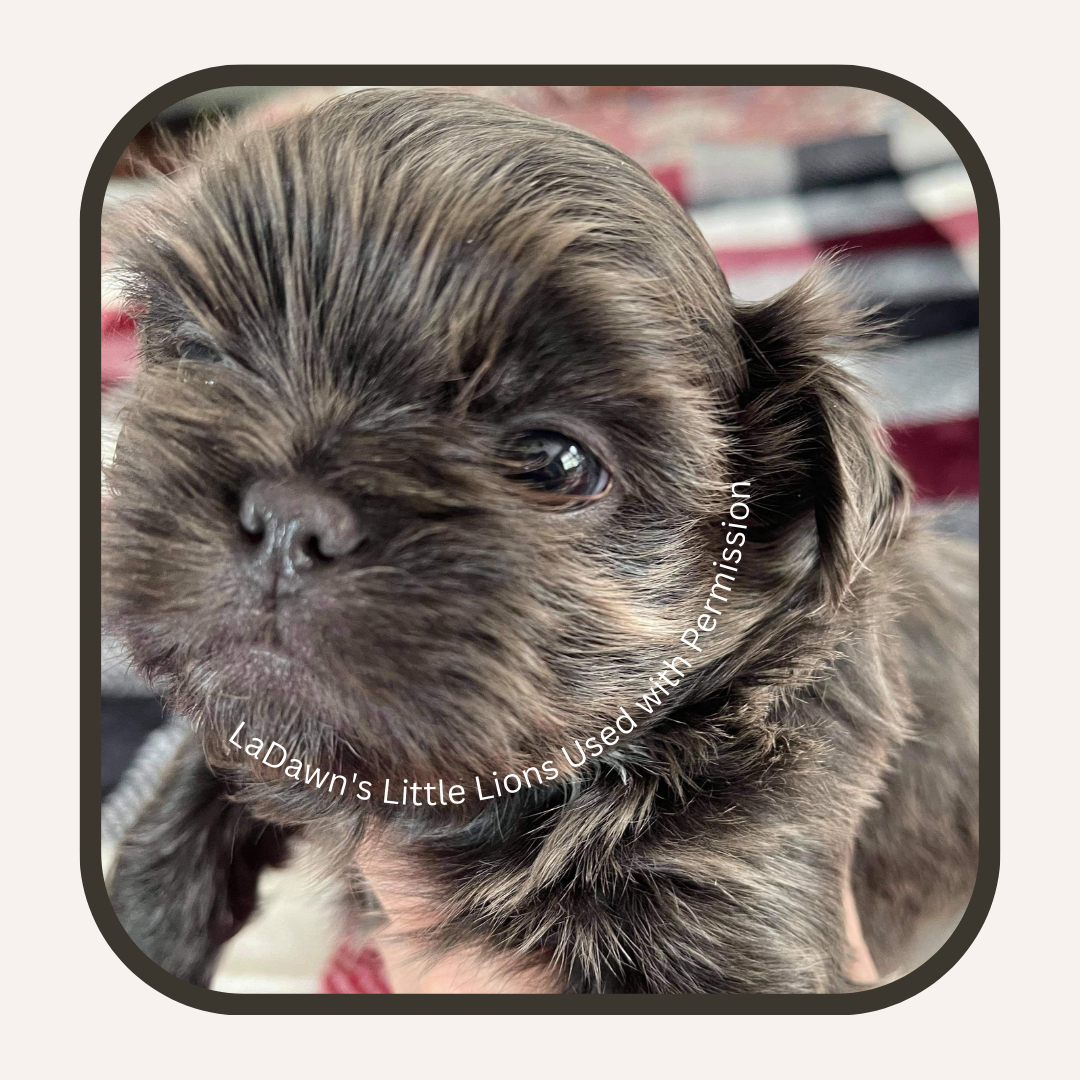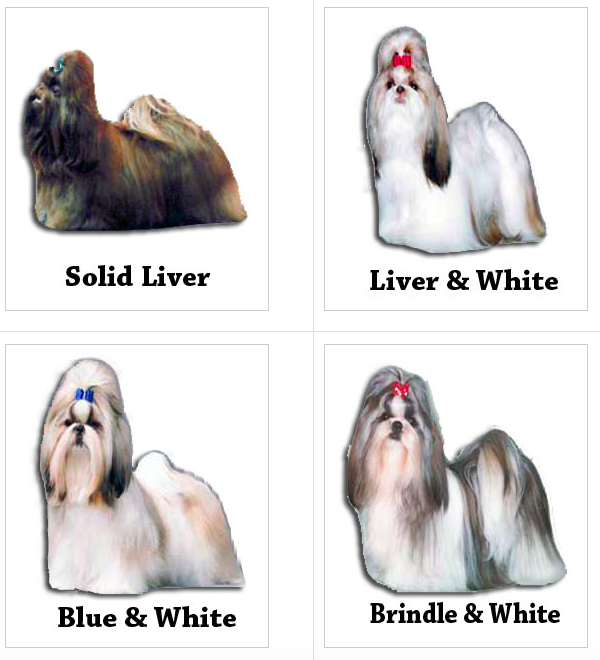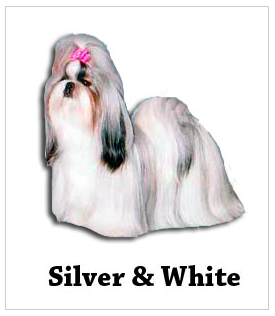AKC Shih TZu Colors...
Shih Tzu are classified by their pigment of the nose, skin, and foot pads.
The possibilities for pigment colors are:
The possibilities for pigment colors are:
Black |
Blue |
Liver |
Lavender |
Black dogs can be any coat color and are registered with AKC with their coat color.
All Shih Tzu with brown noses will be registered as LIVER, the color of the coat doesn't matter. Liver Shih Tzu can have any color and pattern of coat, but a liver dog will never have any black hair anywhere on its body.
All Shih Tzu with brown noses will be registered as LIVER, the color of the coat doesn't matter. Liver Shih Tzu can have any color and pattern of coat, but a liver dog will never have any black hair anywhere on its body.
AKC Shih Tzu Color Examples
Rare Shih Tzu Colors
There are NO rare colors for the Shih Tzu breed.
Don't be fooled into thinking that just because a breeder tells you that their puppy's color is rare, that it really is... All colors and coat patterns are equally acceptable by the AKC, but there is one color that is not yet AKC recognized, that is lavender.
Lavender and Blue are less known colors, but not rare. In the past several years the dilute colors have become more popular and can be found across the world.
Lavender occurs when a dog with liver pigment allele is changed because of the dilute gene (dd). Genetically the dog will be b/b on the B locus, and d/d on the D locus (both fully recessive traits - which means they need a copy from each parent to express the trait).
Blue occurs when the black pigment is changed by the dilution gene. Genetically the dog will be B/B or B/b on the B locus, and d/d on the D locus (dilute is the only recessive trait in the blue combo - which means they need a copy of the dilute gene from each parent to express the trait but only one parent needs to pass on the "B" to be blue).
Don't be fooled into thinking that just because a breeder tells you that their puppy's color is rare, that it really is... All colors and coat patterns are equally acceptable by the AKC, but there is one color that is not yet AKC recognized, that is lavender.
Lavender and Blue are less known colors, but not rare. In the past several years the dilute colors have become more popular and can be found across the world.
Lavender occurs when a dog with liver pigment allele is changed because of the dilute gene (dd). Genetically the dog will be b/b on the B locus, and d/d on the D locus (both fully recessive traits - which means they need a copy from each parent to express the trait).
Blue occurs when the black pigment is changed by the dilution gene. Genetically the dog will be B/B or B/b on the B locus, and d/d on the D locus (dilute is the only recessive trait in the blue combo - which means they need a copy of the dilute gene from each parent to express the trait but only one parent needs to pass on the "B" to be blue).
Dilute Dog health concerns
Color Dilution Alopecia (CDA) or commonly referred to as simply alopecia, is a concern with dilute dogs only.
Alopecia is a genetic recessive inherited condition that causes patches of hair thinning or loss and may also include flaky and/or itchy skin of some blue and lavender dogs.
These puppies are usually born with a normal-looking coat, and the visible signs of CDA may begin to manifest as early as 8 weeks, at six months of age, or older.
Because dilute dogs (blue & lavender) lack melanin, this affects the ability they have to produce healthy skin and hair. This means that the hair follicles have abnormalities causing them to self-destruct. So the hair in affected areas can begin to break off and not re-grow, causing a bald or patchy looking coat. The most common areas affected are the ears and trunk of the body, but anywhere that the blue or lavender hair is on the dog's body can be affected.
The overall health of the dog is not necessarily affected by CDA, but there can be some skin-specific issues that will emerge that will require treatment. Many dogs will have itching in the bald areas that can be managed, others can develop scaly skin, bumps or pustules associated with common skin infection.
There are no tests currently for CDA genes despite ongoing research. Because of the inheritable genetic nature of this disease any parents who produce puppies with CDA should NOT be paired together again. If a breeder continually breeds dogs together that produce defects like CDA, you should ask yourself why!
Allergies, Skin Problems, Midline Defects, Ear Infections, and General Health - Commonly, dogs who are dilute are more prone to have allergies that affect their ears and skin. They are also more prone to food allergies and skin disorders crop up more frequently. In our experience and the experience of many long-time breeders midline defects (cleft palate, spina bifida), respiratory distress, and other neurological defects are much more common among our dilute puppies.
One of the main responsibilities of ethical breeders is to produce healthy dogs, so we choose not to use dilute dogs as breeding mothers. We do have dogs who carry dilute genes, but we are very careful in selecting dogs who don't come from lines with known alopecia. If we have a dog who produces alopecia ( only once in 23+ years), we will not pair that dog with another dilute carrier again.
My intention in sharing all of this information is not to shame any breeders or scare anyone away from owning or purchasing a blue or lavender puppy/dog. There are many dilute dogs who have happy healthy lives. I merely share in order to inform buyers, breeders, and friends about the issues surrounding the dilute colors.
Alopecia is a genetic recessive inherited condition that causes patches of hair thinning or loss and may also include flaky and/or itchy skin of some blue and lavender dogs.
These puppies are usually born with a normal-looking coat, and the visible signs of CDA may begin to manifest as early as 8 weeks, at six months of age, or older.
Because dilute dogs (blue & lavender) lack melanin, this affects the ability they have to produce healthy skin and hair. This means that the hair follicles have abnormalities causing them to self-destruct. So the hair in affected areas can begin to break off and not re-grow, causing a bald or patchy looking coat. The most common areas affected are the ears and trunk of the body, but anywhere that the blue or lavender hair is on the dog's body can be affected.
The overall health of the dog is not necessarily affected by CDA, but there can be some skin-specific issues that will emerge that will require treatment. Many dogs will have itching in the bald areas that can be managed, others can develop scaly skin, bumps or pustules associated with common skin infection.
There are no tests currently for CDA genes despite ongoing research. Because of the inheritable genetic nature of this disease any parents who produce puppies with CDA should NOT be paired together again. If a breeder continually breeds dogs together that produce defects like CDA, you should ask yourself why!
Allergies, Skin Problems, Midline Defects, Ear Infections, and General Health - Commonly, dogs who are dilute are more prone to have allergies that affect their ears and skin. They are also more prone to food allergies and skin disorders crop up more frequently. In our experience and the experience of many long-time breeders midline defects (cleft palate, spina bifida), respiratory distress, and other neurological defects are much more common among our dilute puppies.
One of the main responsibilities of ethical breeders is to produce healthy dogs, so we choose not to use dilute dogs as breeding mothers. We do have dogs who carry dilute genes, but we are very careful in selecting dogs who don't come from lines with known alopecia. If we have a dog who produces alopecia ( only once in 23+ years), we will not pair that dog with another dilute carrier again.
My intention in sharing all of this information is not to shame any breeders or scare anyone away from owning or purchasing a blue or lavender puppy/dog. There are many dilute dogs who have happy healthy lives. I merely share in order to inform buyers, breeders, and friends about the issues surrounding the dilute colors.
Merle Shih Tzu
Merle is not an acceptable Shih Tzu color
If you find someone claiming to have a Merle Shih Tzu - this is a mixed breed dog! Somewhere along the lines a breeder has bred a different breed into their lines to get Shih Tzu who have that gene.
The Shih Tzu is one of the most ancient breeds, and merle has NEVER been a color in this historic breed. **Even if they can show you genetic tests that show they are 100% Shih Tzu, that just means that the breed cross happened more than 4-5 generations back and the puppies have then only been bred back exclusively to other purebred Shih Tzu.
If you find someone claiming to have a Merle Shih Tzu - this is a mixed breed dog! Somewhere along the lines a breeder has bred a different breed into their lines to get Shih Tzu who have that gene.
The Shih Tzu is one of the most ancient breeds, and merle has NEVER been a color in this historic breed. **Even if they can show you genetic tests that show they are 100% Shih Tzu, that just means that the breed cross happened more than 4-5 generations back and the puppies have then only been bred back exclusively to other purebred Shih Tzu.
Common Coat Patterns & Terms
**There are no 'RARE' colors or marking, although some are more common than others...

White Markings & Tuxedo~ These dogs are usually one basic color (or brindle) with minimal white. White markings is commonly referred to when a dog has small patches of white coloring on the chest, toes, tip of the tail, etc. - sometimes referred to as 'abstract' or 'minimal' white markings. Tuxedo marked dogs have a large white patch on the chest (shirt front) and chin, and some white on the feet/toes/ The darker color extends down the legs to resemble the Tuxedo jacket. The dog will have significantly less than 50% of its body with white hair. Sometime the term 'Irish Spotting' may be used, but it is believed that this is controlled by a different gene. White spotting is controlled by the S locus. If a dog has white or tuxedo markings they will most likely only have one copy of the spotting gene (S/sp).
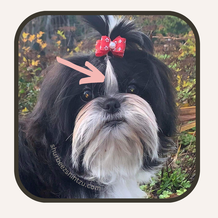
Blaze ~ A white stripe running up the center of the face, usually between the eyes usually ends before the crown of the head. It can be seen on abstract, tuxedo, or parti colored Shih Tzu and is controlled by the spotting gene on the S locus.

Flare ~ A blaze that widens as it approaches the crown of the head. Flare is controlled by the spotting gene on the S locus. It can be seen as white markings on, solid, tuxedo, or parti colored Shih Tzu.

Collar or Shawl ~ White marking around the neck, can be a full circle or partially around the neck. It can be seen on a tuxedo or parti colored Shih Tzu, although it may be less visible on a parti patterned coat. Collar and shawl type markings are controlled by the spotting gene on the S locus.

Dobie or Tan Points ~ Many Shih Tzu breeders refer to tan points (markings like a Doberman pinscher) as 'dobie'. There are possibilities of tan points with abstract, parti, or solid color dogs. The tan points can range in color from dark red, to cream, to almost white. The parti or spotting gene can mask (hide) some of the tan point expression, making it hard to determine visually whether the dog is actually expressing tan points. The saddle tan gene (RALY) also affects the tan points. It makes the tan color spread farther than they would in a classically tan pointed dog. The recessive red gene can mask all of the tan points coloring completely resulting in an all red, white, or cream dog (or parti coloring) with no visible tan points. Dobie is possible in black, blue, liver, or lavender pigmented Shih Tzu. Many times sable coloring is mistaken for tan points when pups are first born. If a puppy has any red or tan color behind the ears on the main body, or a stripe down the back that puppy will NOT be a dobie colored pup. Tan points can also be brindle patterned.

Eye Stripes ~ Dark shading from the inner corner of the eyes that resemble an eyebrow. Usually, black hair in a black pigmented dog, and dark brown in a liver pigmented dog. Eye stripes are thought to be controlled by the masking gene on the E locus,(Em).

Mask ~ Dark shading on the muzzle, possibly up to the eyebrows, or the entire face and head. Masking can also add dark color to the tips of the ears, chest, across the length of the back, and also to the tips of the feet and tail. The degree of masking can vary from dog to dog. It is controlled by the masking gene on the E locus, (EM). Some masks fade as the puppy ages, and other masks will remain visible for the life of the dog.

Saddle ~ A large patch of color over the back, where a blanket or saddle would go. The size, placement, and pattern of the saddle is controlled by the spotting gene on the S locus. The saddle can be full - extending the length of the back and onto the legs, or partial/spotted.

Parti ~ A parti marked dog is a white dog with colored patches. The colored patches can be solid, brindled, display sable coloring (gold or red with black hairs interspersed), or have tan points in them. There can be a lot of color but usually 50% or more of the dog is white. The parti gene is a recessive trait and must be passed on from both parents. It is controlled by the S locus, a parti dog will have (sp/sp) on their S locus, while a carrier of parti will show (S/sp) when tested.
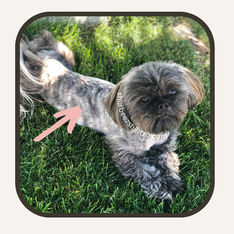
Brindle ~ Typically appears as black stripes on a red, gold, or silver base. The stripes are eumelanin (black/brown pigment) and the base is phaeomelanin (red/yellow pigment), so the appearance of the black and red pigments can be changed by any of the genes which usually affect them.
Brindle is caused by a complex gene process and is technically a form of mosaicism, where some cells express one allele (KB) and other cells express a different allele (ky) producing the striping effect we see. The current test for brindle is quite extensive so there are currently no commercially available tests that are able to detect brindle alleles. Brindle dogs will usually test as KBky, and carriers (one dominant black allele, one brindle) cannot be identified without breeding, so many times we assume that any dog that is KBky can produce brindle puppies.
- Eumelanin (the pigment making up the stripes) can be affected by: liver, dilution, greying, and recessive red.
Brindle is caused by a complex gene process and is technically a form of mosaicism, where some cells express one allele (KB) and other cells express a different allele (ky) producing the striping effect we see. The current test for brindle is quite extensive so there are currently no commercially available tests that are able to detect brindle alleles. Brindle dogs will usually test as KBky, and carriers (one dominant black allele, one brindle) cannot be identified without breeding, so many times we assume that any dog that is KBky can produce brindle puppies.
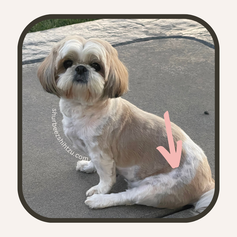
Ticking ~ Tiny spots that appear in the white patches of the hair as the dog matures. This resembles the spots on a Dalmatian Dog . Many times the ticking can be seen on the skin without affecting the hair color.

